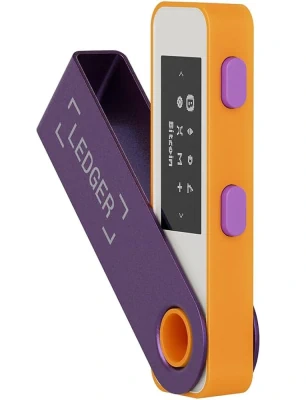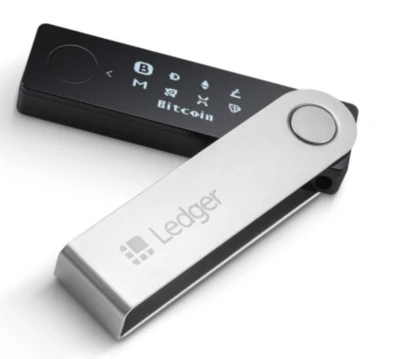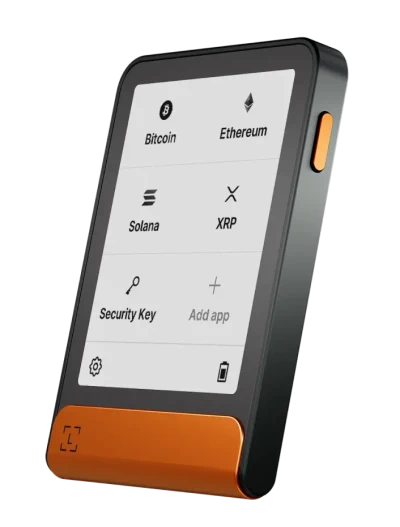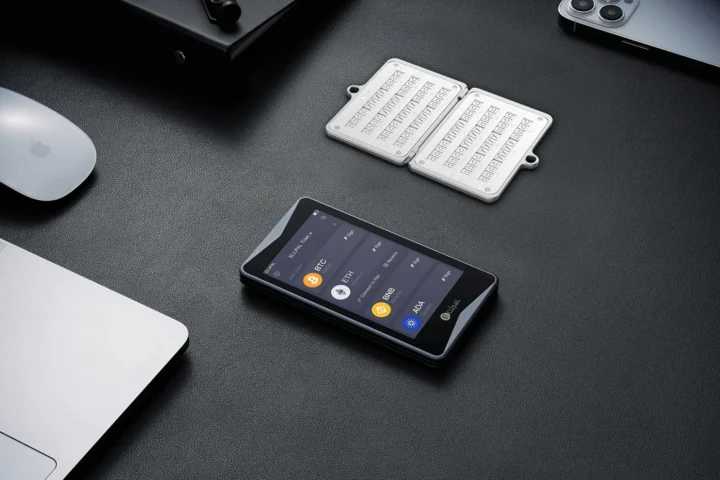Ledger is a leading provider of hardware wallets for cryptocurrency, known for their commitment to security and user-friendliness. Their range of wallets caters to different needs and preferences, offering a variety of features and price points. Let’s explore the different Ledger wallets available today:
The Ledger Nano S Plus is Ledger’s most popular wallet, offering support for over 5,500 cryptocurrencies and tokens. It features a robust security system powered by a Certified Secure Element (CC EAL6+) chip. The Nano S Plus is a compact and lightweight wallet with a sleek design. Its dimensions are 62.39 x 17.40 x 8.24mm and weighs 21g. The wallet is made of brushed stainless steel and plastic and connects via a USB Type-C port. The Nano S Plus is compatible with Windows, macOS and Ubuntu operating systems.
The Ledger Nano X is Ledger’s most advanced Bluetooth-enabled hardware wallet, allowing you to securely manage your crypto assets on all platforms. It boasts a Certified Secure Element (CC EAL5+) chip and a built-in rechargeable battery. The Nano X has a slightly larger footprint than the Nano S Plus, measuring 72mm x 18.6mm x 11.75mm and weighing 34g. It features a brushed stainless steel and plastic design and connects via a USB Type-C port. The Nano X is also compatible with all moders Windows, macOS and Linux based operating systems.
The Ledger Stax is a premium hardware wallet designed for a seamless and secure user experience. It features a curved E Ink® touchscreen, allowing for easy navigation and confirmation of transactions. Powered by a Certified Secure Element (CC EAL6+) chip and Ledger OS, the Stax offers a high level of security. The wallet is credit card-sized, measuring 85 x 54 x 6mm and weighing 45g. It supports wireless charging and connects via USB-C, Bluetooth®, and NFC. The Stax is compatible with Windows, macOS, Linux, Android, and iOS operating systems.
The Ledger Flex is Ledger’s latest hardware wallet, offering a more affordable option with touchscreen technology. It features a secure E Ink® touchscreen, providing a user-friendly interface for managing your crypto assets. The Flex is smaller than the Stax, making it more portable. It also utilizes a Certified Secure Element (CC EAL6+) chip and Ledger OS for robust security. The Flex connects via a USB-C port and is compatible with a range of operating systems, including Windows, macOS, and Android.
Ledger Nano S (Discontinued)
The Ledger Nano S was a popular hardware wallet that has been discontinued. It provided basic functionality for managing cryptocurrency and offered a secure platform for storing digital assets. While the Nano S is no longer available for purchase, it remains a reliable option for users who already own one.
Ledger Nano S Plus

The Ledger Nano S Plus is Ledger’s flagship hardware wallet, renowned for its comprehensive support of over 5,500 cryptocurrencies and tokens. At the heart of its security lies a Certified Secure Element (CC EAL6+) chip, ensuring the highest level of protection for your digital assets. The Nano S Plus is a compact and lightweight wallet, measuring 62.39 x 17.40 x 8.24mm and weighing 21g. Its sleek design is crafted from brushed stainless steel and plastic, and it connects to your computer via a USB Type-C port. The Nano S Plus is compatible with various operating systems, including Windows 10/11, macOS Big Sur / Monterey / Ventura, and Ubuntu LTS 20.4 / 22.04, making it a versatile choice for diverse users.
Ledger Nano X

The Ledger Nano X stands out as Ledger’s most advanced Bluetooth-enabled hardware wallet, designed to provide secure management of your cryptocurrency assets across various platforms. It incorporates a Certified Secure Element (CC EAL5+) chip, a hallmark of Ledger’s commitment to robust security. The Nano X is a compact device, measuring 72mm x 18.6mm x 11.75mm and weighing 34g. Its sleek design features brushed stainless steel and plastic, and it connects to your computer via a USB Type-C port. The Nano X is compatible with a wide range of operating systems, including Windows 10/11, macOS Big Sur / Monterey / Ventura, and Ubuntu LTS 20.04 / 22.04, ensuring its compatibility with a diverse user base.
Ledger Stax

The Ledger Stax represents a premium hardware wallet that prioritizes a seamless and secure user experience. It features a groundbreaking curved E Ink® touchscreen, allowing for intuitive navigation and confirmation of transactions. This innovative design, coupled with a powerful Certified Secure Element (CC EAL6+) chip and Ledger OS, ensures exceptional security for your digital assets. The Stax boasts an impressive battery life, lasting for days on standby and up to 10 hours in active use. It also supports wireless charging, adding convenience to its features. The Stax seamlessly connects to your iOS, Android smartphone, or desktop computer, enabling a simple and unified experience across multiple platforms.
Ledger Flex

The Ledger Flex marks Ledger’s next generation of hardware wallets, offering a secure and user-friendly experience at a more accessible price point. It features a responsive E Ink® touchscreen, providing an intuitive interface for managing your cryptocurrency assets. The Flex is designed for portability, making it a convenient option for users on the go. It incorporates a robust Certified Secure Element (CC EAL6+) chip and Ledger OS, ensuring the same high level of security that Ledger is known for. The Flex connects to your computer via a USB-C port and is compatible with a range of operating systems, including Windows, macOS, and Android, making it adaptable to various user preferences.
Ledger Nano S (Discontinued)
The Ledger Nano S was a popular hardware wallet that has been discontinued by Ledger. It offered a secure platform for storing cryptocurrency assets, providing basic functionality for managing your digital holdings. The Nano S was known for its simplicity and ease of use, attracting a wide range of users. Despite being no longer available for purchase, the Ledger Nano S remains a viable option for users who already own one and are familiar with its features; While it may lack the advanced features of newer models, it continues to provide a secure and reliable solution for storing your crypto assets.
Ledger Live App
The Ledger Live app is an essential companion for your Ledger hardware wallet, providing a user-friendly interface to manage your cryptocurrency assets.
Downloading Ledger Live
To begin using Ledger Live, the first step is to download the app. It’s available for various platforms, including Windows, macOS, Linux, Android, and iOS. Simply visit the official Ledger website and navigate to the downloads section. Select the version compatible with your operating system and follow the on-screen instructions to install the app. Once installed, you’ll be ready to create an account and connect your Ledger wallet.
Logging In and Setting Up
Once you have downloaded and installed Ledger Live, you’ll need to create an account. The process is straightforward, requiring you to provide a valid email address and choose a strong password. After setting up your account, connect your Ledger wallet to your computer using a USB cable or Bluetooth connection. Ledger Live will guide you through the initial setup process, which involves generating a recovery phrase. This phrase is crucial for recovering your crypto assets if you lose your device. Be sure to write down the recovery phrase and store it in a secure location.
Updating Ledger Live
Ledger Live is constantly being updated with new features, bug fixes, and improved security measures. To ensure you’re using the latest version, it’s essential to update the app regularly. Ledger Live will notify you when an update is available. Simply click on the notification and follow the on-screen instructions to download and install the update. Updating the app is a simple process that usually takes a few minutes. It’s recommended to keep your Ledger Live app up-to-date to benefit from the latest improvements and enhance the security of your cryptocurrency assets.
Ledger Security
Ledger is known for its commitment to providing secure hardware wallets for cryptocurrency users.
Ledger Hardware Wallet Security
Ledger hardware wallets employ several layers of security to protect your cryptocurrency assets. At the core of each wallet is a Certified Secure Element (CC EAL6+) chip for Ledger Nano S Plus, Ledger Flex, and Ledger Stax, and a Certified Secure Element (CC EAL5+) chip for the Ledger Nano X. These chips act as a secure enclave, generating and storing your private keys offline, making them inaccessible to hackers. Ledger wallets are designed to be tamper-proof, and any attempt to compromise the device will be detected and prevent unauthorized access. Furthermore, Ledger uses a proprietary operating system called Ledger OS, which is isolated from the internet and designed to resist malware attacks.
Ledger Live App Security
The Ledger Live app is designed to complement the security of your Ledger hardware wallet. It incorporates features such as two-factor authentication (2FA) to protect your account from unauthorized access. Ledger Live also uses encryption to secure your data when it’s being transmitted between your device and the app. It’s important to note that Ledger Live does not store your private keys; these are securely stored on your Ledger hardware wallet. The Ledger Live app acts as an interface to interact with your wallet, but your private keys remain protected within the secure element of your hardware wallet.
Has Ledger Ever Been Hacked?
Ledger wallets has a strong track record of security, and there have been no reported instances of direct hacks targeting the hardware wallets themselves. However, in December 2023, a former Ledger employee fell victim to a sophisticated phishing attack that compromised their NPMJS account, allowing an attacker to publish malicious code. This incident highlights the importance of maintaining robust security practices, including strong passwords and multi-factor authentication (2FA), to protect against phishing attempts and other cyber threats. Ledger has addressed the incident and implemented measures to strengthen its security protocols.
Ledger Supported Coins
Ledger wallets support a wide range of cryptocurrencies and tokens.
Coin Compatibility
Ledger hardware wallets are designed to be compatible with a wide range of cryptocurrencies and tokens. The exact list of supported coins may vary depending on the specific Ledger wallet model. However, Ledger generally supports a vast number of crypto assets, including major cryptocurrencies like Bitcoin (BTC) and Ethereum (ETH), as well as numerous altcoins and tokens. Ledger actively updates its list of supported coins, adding new assets as they become available. To check the compatibility of a specific coin, you can refer to the official Ledger website or the Ledger Live app.
Ledger Staking Process
Ledger hardware wallets provide a secure way to participate in cryptocurrency staking. Staking is a process where you hold cryptocurrency in a wallet to support the network and earn rewards; To stake coins using a Ledger wallet, you’ll need to connect your wallet to the Ledger Live app. Within the app, navigate to the “Staking” section. Ledger Live will display a list of supported coins that can be staked. Select the coin you want to stake and follow the on-screen instructions. The staking process may vary depending on the specific cryptocurrency and staking platform.
Ledger vs Trezor
Ledger and Trezor are two of the most popular and reputable hardware wallet manufacturers.
Key Differences
While both Ledger and Trezor are renowned for their security and reliability, they differ in several key aspects. Ledger wallets offers a wider range of hardware wallet models, including the Nano S Plus, Nano X, Stax, and Flex, catering to various needs and budgets. Trezor, on the other hand, has a more streamlined product lineup with the Trezor Model T and Trezor One. Ledger’s wallets are generally known for their user-friendly interface and comprehensive app support, while Trezor wallets are often praised for their open-source nature and emphasis on privacy. Ultimately, the best hardware wallet for you will depend on your specific requirements and preferences.










